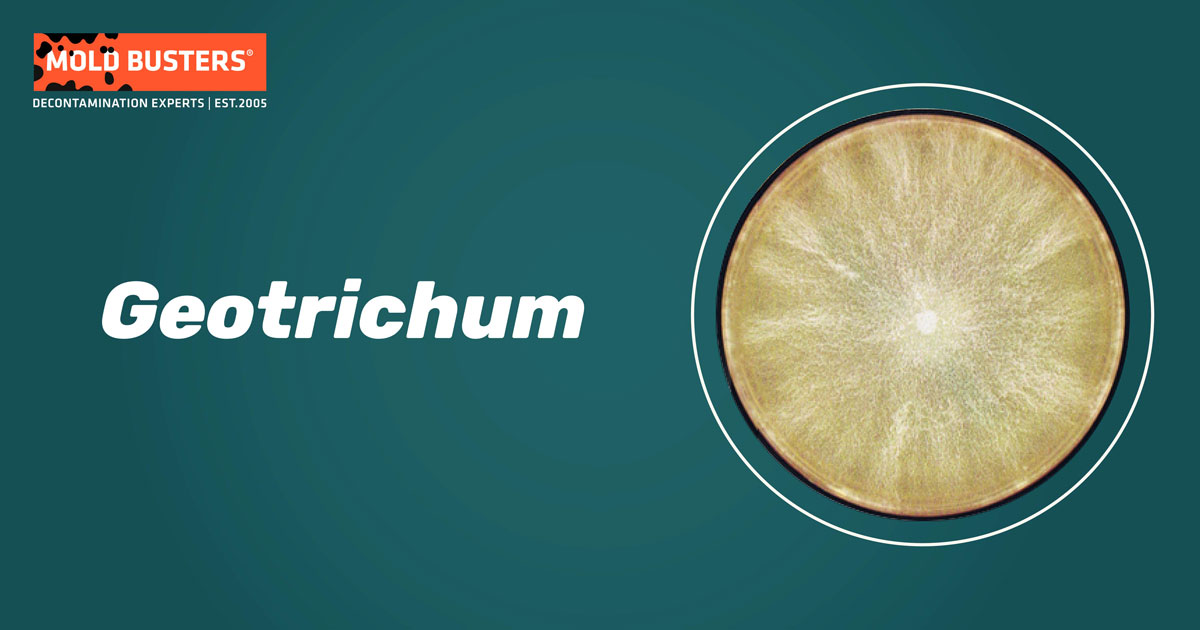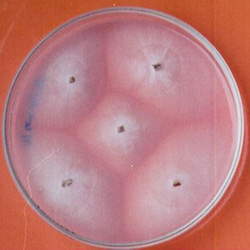Geotrichum is a common mold genus that can be found. They also grow on plants, dairy products, and cereal grains. They can also act as opportunists human pathogens, usually involving immunocompromised individuals. However, certain Geotrichum species are considered a normal part of human flora.

What is Geotrichum mold?
The genus Geotrichum was erected by the description of Geotrichum candidum. C. candidum is a common member of the human microbiome but can be pathogenic to both humans and plants. In humans, it is mostly associated with the skin, feces, and sputum, occurring in about 30% of specimens [1]. It has also been isolated from the soil all over the world and causes sour rot in many fruit and vegetable hosts. Furthermore, it is used in the production of various dairy products such as rind cheeses [2].
Geotrichum colonies are white, flat, and have a powdery or waxy texture. Geotrichum has a rapid growth rate, and its dry spores disperse easily through the air, making them easy to inhale.

What are known Geotrichum species?
Although the Geotrichum genus formerly comprised over 100 species, today it contains approximately twenty species [3]. Many species have been transferred to the Saprochaeta genus, including clinically relevant species such as G. capitatum and G. clavatum (currently known as S. capitata and S. clavata).
Most Geotrichum/Saprochaeta infections are associated with S. capitata, while S. clavata are somewhat less common. However, these two species cannot be distinguished by biochemical methods and misidentification is frequent [4]. G. candidum is even less frequently reported as a human pathogen, but it may lead to disseminated and invasive diseases with high mortality [5].
Where can Geotrichum be found?
Geotrichum species are truly cosmopolitan and can be found in almost all the parts of the world. They mostly colonize the soil, but can also be found in the water and its spores are ever-present in the air. In addition to that, this mold can also be found on plants, dairy products and even in the digestive tract of human beings.
Where can you find Geotrichum mold in the house?
Geotrichum species are cosmopolitan and can be found in almost all regions of the world. They mostly colonize the soil, but can also be found in the water. In addition to that, this mold is also found on plants, dairy products, and even in the digestive tract of human beings. Furthermore, as most molds, Geotrichum fungi require moisture to grow. Areas in your households with higher humidity should be the first places to look for mold growth. Damp areas of the house, such as bathrooms, kitchens, and basements should be regularly checked for mold.
What are the health effects of Geotrichum mold?
Geotrichum mold can cause allergic bronchopulmonary mycosis (ABPM) due to excessive inhalation of fungal spores. In most cases, infants and the elderly are most likely to be affected. Also at risk are individuals with weakened immune systems and those already suffering from pulmonary disorders [6].
Affected people may also begin to experience the usual symptoms of allergy and the common cold. Itchiness in the eyes, vertigo, and fatigue are also some of the other health effects of having mold in your house.
Furthermore, some Geotrichum species can cause invasive fungal diseases in immunocompromised individuals, particularly those suffering from hematological malignancies such as leukemia or lymphoma, and also those suffering from neutropenia [7]. In these cases, the infection reaches internal organs, including, the liver, spleen, kidneys, and the central nervous system, with a high overall mortality rate of 65% [4].
Proper way to remove Geotrichum mold
Geotrichum mold is one of the more hazardous mold types. Some of the factors that make it so dangerous are its abundance in our surroundings and the speed at which it can spread. By far the safest way to remove Geotrichum mold from your house is to enlist the help of professionals.
Due to the seriousness of this mold, it is often a good idea to hire the services of a mold removal company. Our professional technicians will treat your house methodically and thoroughly to ensure that the mold is removed completely so that it does not continue to be a hazard in the future.
At Mold Busters we take pride in being one of the leading companies in the world when it comes to mold remediation. In addition to inspecting and removing any mold infestations from your home, we can advise you on the steps you can take to make your residence mold-free for years to come.

Did you know?
Basements in Canada are the most affected by the Penicillium/Aspergillus mold group?! Find out more exciting mold stats and facts inside our mold statistics page.
References
- Domsch KH, Gams W, Andersen TH (1980). Compendium of soil fungi (2nd ed.). Academic Press, London, UK.
- Pottier I, Gente S, Vernoux JP, Guéguen M (2008). Safety assessment of dairy microorganisms: Geotrichum candidum. Int J Food Microbiol. 126(3):327-32.
- De Hoog GS, Smith MT (2004). Ribosomal gene phylogeny and species delimitation in Geotrichum and its teleomorphs. Studies in Mycology. 50: 489-515.
- Durán Graeff L, Seidel D, Vehreschild MJ, Hamprecht A, Kindo A, Racil Z, Demeter J, De Hoog S, Aurbach U, Ziegler M, Wisplinghoff H, Cornely OA; FungiScope Group (2017). Invasive infections due to Saprochaete and Geotrichum species: Report of 23 cases from the FungiScope Registry. Mycoses. 60(4):273-279.
- Henrich TJ, Marty FM, Milner DA, Thorner AR (2009). Disseminated Geotrichum candidum infection in a patient with relapsed acute myelogenous leukemia following allogeneic stem cell transplantation and review of the literature. Transpl Infect Dis. 11:458–462.
- Simon-Nobbe B, Denk U, Pöll V, Rid R, Breitenbach M (2008). The Spectrum of Fungal Allergy. Int Arch Allergy Immunol. 145:58–86
- Trabelsi H, Néji S, Gargouri L, Sellami H, Guidara R, Cheikhrouhou F, Bellaaj H, Makni F, Elloumi M, Ayadi A (2015). Geotrichum capitatum septicemia: case report and review of the literature. Mycopathologia. 179(5-6):465-9.

Get Special Gift: Industry-Standard Mold Removal Guidelines
Download the industry-standard guidelines that Mold Busters use in their own mold removal services, including news, tips and special offers:

Written by:
John Ward
Account Executive
Mold Busters
Edited by:
Dusan Sadikovic
Mycologist – MSc, PhD
Mold Busters
